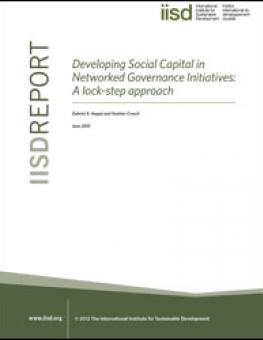
Developing Social Capital in Networked Governance Initiatives: A lock-step approach
Globally, there is an increasing recognition that technocratic approaches have limitations, especially when it comes to solving complex problems that span numerous administrative boundaries and fragmented institutions.
Where policy problems exceed a certain level of complexity and significance, and where existing institutions are too weak to manage these problems, empirical evidence suggests that polycentric arrangements, such as networked governance initiatives, emerge to produce solutions that are more beneficial. By integrating distributed capacities for collective problem solving, governance networks allow diverse actors to work collaboratively towards mutually beneficial outcomes. However, only with an adequate level of social capital can a governance network create shared value and engage in processes of reflexive governance. This paper elaborates on three methods with regards to their potential to enhance social capital in governance networks: institutional brokering, knowledge sharing and social learning, and collaborative visioning.The authors describe a lock-step approach to creating the organizational conditions that enable effective networked governance. At the crux of this approach is the notion that cognitive elements mediate the relationship between the development of networked governance and the maintenance and enhancement of social capital. They identify four stages of networked governance (network architecture, preparing the grounds, collaborative visioning and reflexive governance), and discuss their importance with regards to creating the organizational conditions of social capital and collective cognition that are instrumental for policy and governance innovation.
You might also be interested in
Financial Benefit-Sharing Issues for Critical Minerals: Challenges and opportunities for producing countries
Exploring nuances in the key features of critical minerals and the new challenges and opportunities they present to fiscal regulation.
National State of the Environment Report: Uzbekistan
The National State of the Environment Report (NSoER) is a comprehensive document that provides a snapshot of current environmental trends in Uzbekistan's socio-economic development for citizens, experts, and policy-makers in the country of Uzbekistan.
IGF Case Study: Leveraging Technologies for Gender Equality in Mining Communities
How can sharing technological infrastructure support gender equality and serve the broad betterment of mining communities?
Carbon capture tax credit could cost taxpayers $1B more than expected, PBO warns
A controversial tax credit meant to help jump-start carbon capture projects could cost $1 billion more than the federal government estimated, says the independent parliamentary budget watchdog. In several federal budgets, Finance Canada forecast that the carbon capture, utilization and storage (CCUS) investment tax credit would cost $4.6 billion between 2022-28. The Parliamentary Budget Officer now estimates the CCUS investment tax credit will cost $5.7 billion.